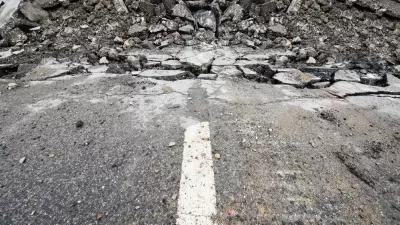While some states are cutting back on transportation expenditures as funds run short, Iowa is not one of them, having passed a 10-cent gas tax increase that took effect March 1. New highway expansions are funded in addition to "fix it first."
Of the eight states that have increased their gas taxes this year (the first seven are here and Nebraska's here), Iowa's 10-cent increase was the highest. Consequently, the Iowa Transportation Commission approved a record spending plan, "highlighted by $3.2 billion for fiscal 2016-20 on highway construction and right-of-way acquisition," writes B.A. Morelli of The Gazette. "The five-year plan is 20 percent larger than the $2.7 billion 2015-19 plan approved last June."
“It is a very balanced approach,” said Commissioner Dan Huber of Davenport. “There’s a significant increase in stewardship. We will be able to do a significant amount of work on existing roads and bridges. We’ve been able to maintain the expansion projects that have been in prior plans, and add some key projects, included [sic] Highway 20, 30 and 61.” [Italics added].
The Associated Press pointed out that the $286.4 for expanding Highway 20 from two to four lanes may be serving an economic stimulus as much as it's sfilling a transportation need.
Iowa Transportation Commissioner Charese Yanney, of Sioux City “it is a proven fact” that economic development in nearby communities increases when highways are expanded to four lanes.
To be sure, the plan does address road and bridge repair and replacement, including "96 bridge replacements at $831 million," according to Morelli.
Nonetheless, the highway projects have left some unhappy with the gas tax increase. According to the Sierra Club Iowa Chapter:
Several organizations launched "fix it first" campaigns to encourage lawmakers to specify in the bills that improvements to current infrastructure should have priority over new construction. That never happened.
While rehabilitating structurally deficient roads and bridges is on the agenda in several eastern Iowa cities, so is widening and adding turn lanes, widening highways and interchanges according to the Cedar Rapids Gazette.
It appears that the chapter did not take a position on the legislation to increase the gas tax, but did take the following position on how to spend gas tax revenue according to their legislative blog:
The Chapter opposes (a)ny increase in the gas tax for new highway construction. In the event the gas tax is increased, Sierra Club supports only using the funds to repair existing highways and infrastructure.
The above-referenced Cedar Rapids Gazette article, also written by Morelli, describes in detail how some of the additional $200 million in new funds made possible by the 10-cent gas tax increase will benefit local counties and cities which will receive 32.5 percent and 20 percent, respectively, with the remaining "47.5 percent for Iowa’s primary highways and interstates."
“It’s a start,” said Ron Knoche, public works director in Iowa City. “The reason why when we talk about these things — road rehabilitation and resurfacing as opposed to new roads or reconstruction — is because we are behind on maintenance of our road system.
"As of 2009, two-thirds of Iowa City’s pavement is in fair or poor condition," he said.
Hat tip: Clyde Anderson, Sierra Club Transportation Committee
FULL STORY: Iowa Transportation Commission approves $3.2 billion highway plan

Alabama: Trump Terminates Settlements for Black Communities Harmed By Raw Sewage
Trump deemed the landmark civil rights agreement “illegal DEI and environmental justice policy.”

Study: Maui’s Plan to Convert Vacation Rentals to Long-Term Housing Could Cause Nearly $1 Billion Economic Loss
The plan would reduce visitor accommodation by 25% resulting in 1,900 jobs lost.

Why Should We Subsidize Public Transportation?
Many public transit agencies face financial stress due to rising costs, declining fare revenue, and declining subsidies. Transit advocates must provide a strong business case for increasing public transit funding.

Paris Bike Boom Leads to Steep Drop in Air Pollution
The French city’s air quality has improved dramatically in the past 20 years, coinciding with a growth in cycling.

Why Housing Costs More to Build in California Than in Texas
Hard costs like labor and materials combined with ‘soft’ costs such as permitting make building in the San Francisco Bay Area almost three times as costly as in Texas cities.

San Diego County Sees a Rise in Urban Coyotes
San Diego County experiences a rise in urban coyotes, as sightings become prevalent throughout its urban neighbourhoods and surrounding areas.
Urban Design for Planners 1: Software Tools
This six-course series explores essential urban design concepts using open source software and equips planners with the tools they need to participate fully in the urban design process.
Planning for Universal Design
Learn the tools for implementing Universal Design in planning regulations.
Smith Gee Studio
Alamo Area Metropolitan Planning Organization
City of Santa Clarita
Institute for Housing and Urban Development Studies (IHS)
City of Grandview
Harvard GSD Executive Education
Toledo-Lucas County Plan Commissions
Salt Lake City
NYU Wagner Graduate School of Public Service





























